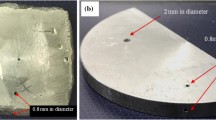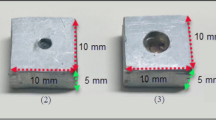Abstract
The lightweight die-casting Al-alloys have become a more appropriate material in many industrial applications. However, the product’s quality has been affected due to existing internal casting defects and the impregnation technique used to overcome drawbacks and improve alloys’ useability. This paper discusses the use of microfocus X-ray computed tomography (XCT) to examine Al-alloy’s die-casting internal deformity, identify the impregnation technique’s effectiveness in sealing porosity non-destructively. Also, we recognize the presence of low atomic number polymer resin (P601) inside the alloy’s defects quantitatively. 3D CT images with transparent effects were generated with a direct conversion X-ray flat panel detector to visualize internal casting defects in the entire samples. The gray-value contrast of 2D slice CT images was excellent to distinguish the resin material in the alloy samples qualitatively. The dimensional analysis shows that the impregnated resin does not seal the casting cavity homogeneously, and some air bubbles appeared inside the defects. The dual-energy X-ray CT technique with a photon-counting detector was executed to characterize the impregnant resin in die-casting cavities by its effective atomic numbers. The outcome shows that the resin material present in alloy’s defects is identical to the solid P601 super-sealant impregnant resin, with a 1.81% error margin. Hence, the XCT technique with a direct-conversion CdTe detector can be used as a rapid and detailed non-destructive inspection technique in die-casting industries and improve the impregnation process’s performance.














Similar content being viewed by others
References
Vinarcik EJ (2003) High integrity die casting processes, 1st edn. Wiley, New York, pp 3–25, 145–156
Kaufman JG (2000) Introduction to aluminum alloys and tempers. ASM International, New York
Benedyk JC (2010) Aluminium alloys for lightweight automotive structures, a volume in Woodhead Publishing Series in composite science and engineering, materials, design and manufacturing for lightweight vehicles. pp 79–113
Casarotto F, Franke AJ, Franke R (2012) 6—High-pressure die-cast (HPDC) aluminium alloys for automotive applications. In: Rowe J (ed) Advanced materials in automotive engineering. Woodhead Publishing, London, pp 109–149. https://doi.org/10.1533/9780857095466.109
Dursun T, Soutis C (2014) Recent developments in advanced aircraft aluminium alloys. Mater Des 1980–2015(56):862–871
Fiorese E, Bonollo F, Timelli G et al (2015) New classification of defects and imperfections for aluminum alloy castings. Int J Metalcast 9:55. https://doi.org/10.1007/BF03355602
Kanno T (1997) An Introduction to die casting technology. Nikkan-kogyo-sinbunsha, Tokyo, pp 227–247
American Society for Testing of Materials ASTM E1742/ E1742M, “Standard Practice for Radiography Examination”, Annual book of ASTM standards 2011 (03.03)
Kastner J, Heim D, Salaberger D, Sauerwein Ch, Simon M (2006) Advanced applications of computed tomography by combination of different methods. In: Proceedings of the European conference on nondestructive testing. Berlin, Germany, September 25–29
Baruchel J, Buffiere JY, Maire E, Peix G (eds) (2000) X-ray tomography in material science. Hermes Science Publication, Paris
Salvo L, Cloetens P, Maire E, Zabler S, Blandin JJ, Buffiere JY et al (2003) X-ray micro-tomography an attractive characterization technique in materials science. Nucl Instrum Methods Phys Res Sect B 200:273–286
Reinhart C (2008) Industrial computer tomography—a universal inspection tool. In: 17th world conference on nondestructive testing. 25–28 Oct 2008, Shanghai, China
Ferrucci M (2018) Towards traceability of CT dimensional measurements. In: Carmignato S et al (eds) Industrial X-ray computed tomography. Springer, Cham, pp 229–265
Ohno Y, Torikoshi M, Tsunoo T, Hyodo K (2005) Dual-energy X-ray CT with CdTe array and its extension. Nucl Instrum Methods Phys Res Sect A 548:72–77. https://doi.org/10.1016/j.nima.2005.03.069
Torikoshi M, Tsunoo T, Endo M, Noda K, Kumada M, Yamada S, Soga F, Hyodo K (2001) Design of synchrotron light source and its beamline dedicated to dual-energy X-ray computed tomography. J Biomed Opt 6(3):371–377
Yamashita Y, Kimura M, Kitahara M, Hamaguchi T, Kanno I, Ohtaka M, Hashimoto M, Ara K, Onabe H (2014) Measurement of effective atomic numbers using energy-resolved computed tomography. J Nucl Sci Technol 51(10):1256–1263. https://doi.org/10.1080/00223131.2014.919881
Derzhi N (2012) Method for estimating effective atomic number and bulk density of rock samples using dual energy X-ray computed tomographic imaging. U.S. patent application 13/527,660
Proceeding Industrielle Computertomografie Tagung, Wels. In: Kastner J (ed) (2008). and Wels (2010)
Wells JM (2007) Quantitative XCT evaluation of porosity in an aluminum alloy casting. In: Shape casting: 2nd international symposium, ISBN 978-0-87339-660-8
Kastner J, Harrer B, Degischer HP (2011) High resolution cone beam X-ray computed tomography of 3D-microstructures of cast Al-alloys. Mater Charact 62:99–107
Bandara A, Kan K, Morii H et al (2020) X-ray computed tomography to investigate industrial cast Al-alloys. Prod Eng Res Dev 14:147–156. https://doi.org/10.1007/s11740-019-00946-8
Kan K, Imura Y, Morii H, Kobayashi K, Minemura T, Aoki T (2013) Application of photon-counting X-ray computed tomography to aluminum-casting inspection. World J Nucl Sci Technol 3:106–108
Lauritsch G, Haerer WH (1998) A theoretical framework for filtered back projection in tomosynthesis. Proc SPIE 3338:1127–1137
Schindelin J, Arganda-Carreras I, Frise E et al (2012) Fiji: an open-source platform for biological-image analysis. Nat Methods 9(7):676–682. https://doi.org/10.1038/nmeth.2019 (PMID 22743772)
Kikinis R, Pieper SD, Vosburgh K (2014) 3D Slicer: a platform for subject-specific image analysis, visualization, and clinical support. Intraoper Imaging Image Guid Ther 3(19):277–289 (ISBN: 978-1-4614-7656-6 (Print) 978-1-4614-7657-3)
de Oliveira FB, Stolfi A, Bartscher M, Chiffre L, Neuschaefer-Rube U (2016) Experimental investigation of surface determination process on multi-material components for dimensional computed tomography. Case Stud Nondestruct Test Eval. https://doi.org/10.1016/j.csndt.2016.04.003
Reiter M, Weiß D, Gusenbauer C, Erler M, Kuhn C, Kasperl S, Kastner J (2014) Evaluation of a histogram-based image quality measure for X-ray computed tomography. In: Proceeding’s 5th conference on industrial computed tomography (iCT 2014). Wels, Austria, NDT.net Issue, p 273–282
Jackson DF, Hawkes DJ (1981) X-ray attenuation coefficients of elements and mixtures. Phys Rep 70(3):169–233
Hawkes DJ, Jackson DF (1980) An accurate parametrisation of the X-ray attenuation coefficient. Phys Med Biol 25(6):1167–1171
Divandari M, Campbell J (1999) The mechanism of bubble damage in castings. The first international conference on gating, filling and feeding aluminum casting"AFS. Nashville, TN, USA, p 49–63
Gariboldi E, Bonollo F, Parona P (2010) Handbook of defects in HPDC, 1st edn. Associazione Italiana di Metallurgia, Milan
Niu XP, Hu BH, Pinwill I, Li H (2000) Vacuum assisted high pressure die casting of aluminium alloys. J Mater Process Technol 105:119–127
Dong X, Zhu X, Ji S (2019) Effect of super vacuum assisted high pressure die casting on the repeatability of mechanical properties of Al–Si–Mg–Mn die-cast alloys. J Mater Process Technol 266:105–113. https://doi.org/10.1016/j.jmatprotec.2018.10.030 (ISSN 0924-0136)
Shantz T, Versmold R (2013) Types of vacuum impregnation processes. 2013. https://www.godfreywing.com/hs-fs/hub/107598/file-29521638-pdf/. Accessed 5 July 2021.
Guz T, Leszek R, Marek D (2020) Influence of selected parameters and different methods of implementing vacuum impregnation of apple tissue on its effectiveness. Processes 8(4):428. https://doi.org/10.3390/pr8040428
Acknowledgements
The authors extend their appreciation to the ANSeeN Inc members for technical and instrument support to the XCT. This research did not receive any specific grant from funding agencies in the public, commercial, or not-for-profit sectors.
Author information
Authors and Affiliations
Corresponding author
Ethics declarations
Conflict of interests
The authors declare that they have no competing interests.
Additional information
Publisher's Note
Springer Nature remains neutral with regard to jurisdictional claims in published maps and institutional affiliations.
Rights and permissions
About this article
Cite this article
Soga, N., Bandara, A., Kan, K. et al. Micro-computed tomography to analyze industrial die-cast Al-alloys and examine impregnation polymer resin as a casting cavity sealant. Prod. Eng. Res. Devel. 15, 885–896 (2021). https://doi.org/10.1007/s11740-021-01071-1
Received:
Accepted:
Published:
Issue Date:
DOI: https://doi.org/10.1007/s11740-021-01071-1




